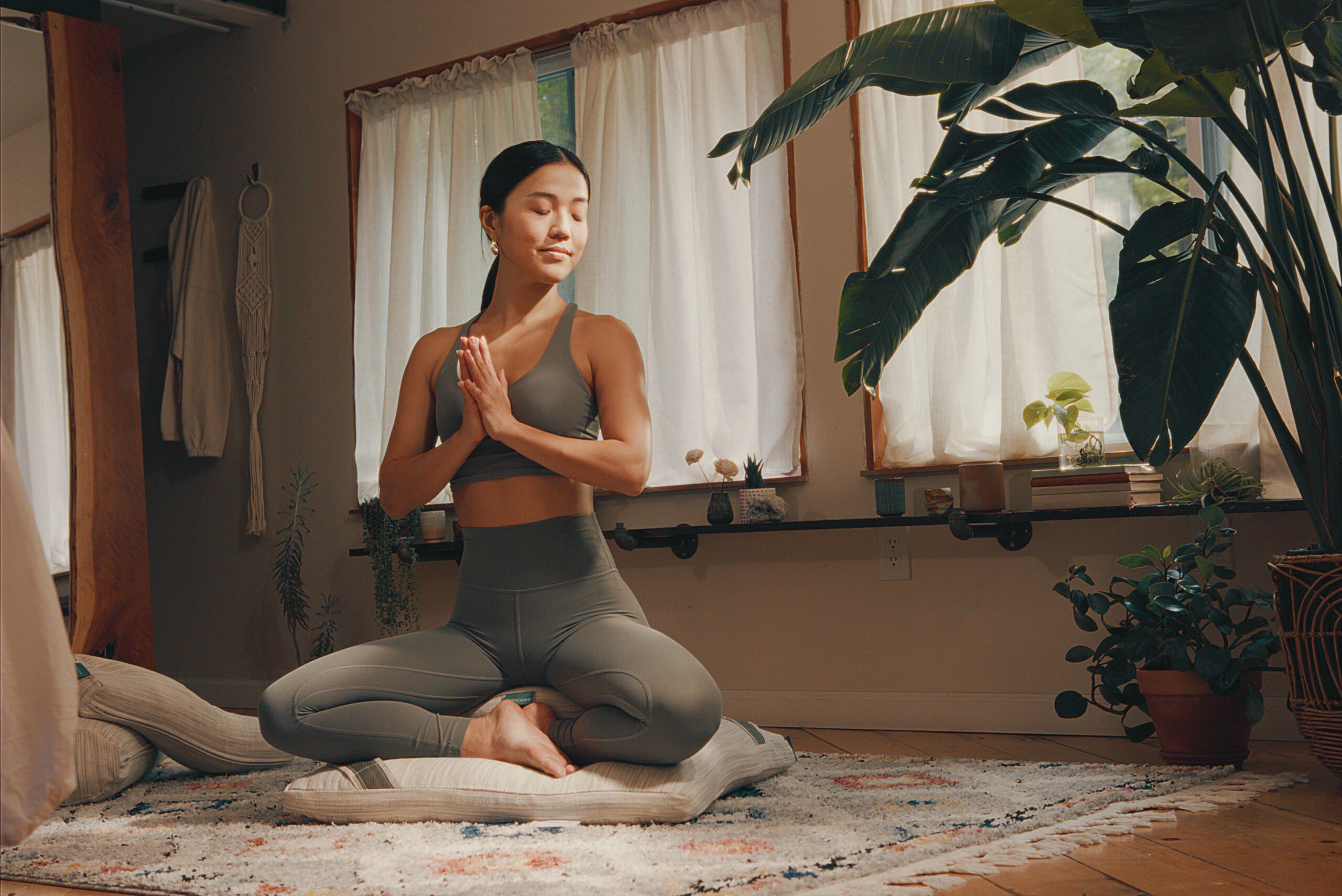When we’re sitting on the couch watching TV, taking a midday stroll, or doing the crossword in bed, we might consider ourselves “resting.” After all, these activities give us a break from our fast-paced, busy lives—and they often feel like incentives for being productive.
But there’s a whole world of relaxation that allows us to sink into a deeper rest than we’ve ever known. Supported by both emerging research and ancient practices, it’s called NSDR: non-sleep deep rest.
Despite its growing popularity, NSDR is far more than a health fad. It’s an umbrella term for relaxation techniques that deeply rest our bodies and minds while remaining conscious. NSDR is doing more than giving us a little break—it’s causing a collective mindset shift on how and why we rest.
Here’s everything you need to know about NSDR’s origins, potential benefits, and methods.

Read More: Toxic Productivity: What It Is and How to Stop
What Is Non-Sleep Deep Rest?
NSDR, or non-sleep deep rest, is a fairly new term for centuries-old relaxation techniques that help us relax and recover without falling asleep. These techniques are thought to enhance focus and cognitive function through breathing exercises, visualization, and attention exercises.
The term NSDR was coined by Andrew Huberman, Ph.D., a neuroscientist and host of the popular science podcast Huberman Lab. He studies brain function and neural plasticity, and his podcast provides listeners with science-based tools to explain the many connections between our brains and bodies. Since NSDR’s inception in 2022, Huberman has spoken extensively about these techniques on other podcasts and used his internet presence to bring NSDR to the masses.
It is worth noting that while grouping deep relaxation techniques into this unified term is a fresh concept, the idea of prioritizing deeper rest is not new. NSDR is born from the Eastern practice of yoga nidra, or “yogic sleep.” Yoga nidra has roots in ancient texts, and in the 20th century it evolved into the yogic tradition practiced today.
NSDR’s Origins In Yoga Nidra
When he coined NSDR, Huberman was already well-acquainted with yoga nidra and its powerful impact. He wanted to bring yoga nidra’s core idea of deep rest to his audiences, but reframe it for Westerners who were less grounded in the spiritual aspects of Eastern yogic practices.
Yoga nidra (AKA yogic sleep or psychic sleep) begins by simply lying down on one’s back in a comfortable and safe environment. It involves techniques like body scanning, focused breathing, and awareness of passing feelings or thoughts. In the Cleveland Clinic article “What Is Yoga Nidra?”, yoga therapist Judi Bar says, “With yoga nidra, you are lying down and the goal is to move into a deep state of conscious awareness sleep, which is a deeper state of relaxation with awareness.” Unlike a midday nap, practitioners of yoga nidra remain awake while entering a total state of relaxation.
In a nutshell, while NSDR and yoga nidra may appear almost identical, yoga nidra is a distinct practice rooted in history and cultural context. NSDR is a Western interpretation of this old tradition, encompassing a broader approach to deep rest and relaxation.
How Does NSDR Work?
Whether you’re doing guided meditation, breathing exercises, body scanning, visualization, or some other form of NSDR, your goal is to deeply relax the body and quiet the mind. But what’s actually happening inside you? Engaging in non-sleep deep rest can simultaneously:
- Decrease activity in the sympathetic nervous system (responsible for our fight-or-flight response)
- Increase activity of the parasympathetic nervous system (responsible for relaxation and recovery)
One of the key components of NSDR—and a major reason behind Dr. Andrew Huberman’s interest in the practice—is its effect on brainwave activity. Techniques like guided meditation and yoga nidra can increase alpha and theta waves, which are associated with deep relaxation, creative thinking, and a meditative state. This brainwave pattern is different from the delta wave activity that dominates during deep, non-REM sleep—a state linked to physical restoration and immune support. While each reflects a different kind of rest, both are essential for maintaining cognitive health, emotional balance, and overall well-being.
In the Sleep Foundation’s article “What is Non-Sleep Deep Rest?”, sleep physician Brandon R. Peters, MD, explains: “NSDR may slow the brain’s electrical waves, inducing a state of relaxation with measurable benefits. Some of the slowing noted in NSDR overlaps with what would be recognized as sleep, including a lack of responsiveness to the environment.”
So, what are the measurable benefits of this practice—the ones we can actually feel on a daily basis?

Read more: The Joy of Doing Nothing: Reclaiming Rest in a Productivity-Focused World
The Potential Benefits Of NSDR
Now that we understand NSDR works on a neurological level, let’s dive into the powerful ways it might improve our overall well-being. Non-sleep deep rest can:
- Minimize stress and anxiety, effectively reducing cortisol levels and leading to a lower stress response.
- Enhance cognitive function, improving essential functions like memory, attention, and processing speed, which benefits both our professional and personal lives.
- Improve sleep quality. Despite NSDR being distinct from sleep, its benefits can improve our sleep quality, remedy sleep disorders, and even alleviate insomnia.
- Benefit us physiologically, promoting lower blood pressure and reduced heart rate while potentially improving our immune system function.
- Transform our relationship with rest, making deep relaxation an essential part of our lives instead of just an incentive after periods of heightened productivity.
How To Practice NSDR
Perhaps one reason non-sleep deep rest is resonating with so many people is how accessible it is. To practice NSDR, all you need is a quiet and comfortable space that promotes focus and relaxation.
Once you’ve found your spot, here’s how to get started:
- Assume a comfy, yet supportive seated position. This can be achieved using pillows or a yoga mat, like this soft, organic one. Sitting upright is often recommended for NSDR practices to minimize the chances of falling asleep, while yoga nidra encourages a horizontal posture called savasana.
- Choose a deep relaxation technique. Newcomers to the practice usually find it helpful to begin with guided meditation like this one by Dr. Huberman or this restorative 20-minute session. These are great introductions to body scanning, breath awareness, and visualization with the help of an expert. Once you’ve found your flow, try these techniques on your own to diversify your practice.
- Be consistent. Even a few minutes per day of NSDR can allow the body and mind to go deeper into relaxation and mindfulness over time.
Duration and time of day might matter, too. Dr. Chris Winter, a neurologist, suggests, “We don’t want to surprise the body with a weird period of inactivity and rest during the middle of the day. Set a designated time for it,” He also warns that keeping NSDR sessions too open-ended or long can lead to “a slowdown of inertia and grogginess.”
Reclaiming Rest In Our Fast-Paced World
While nothing can replace healthy sleep, NSDR can enhance our well-being and rejuvenate our minds in this age of hyper-productivity. It’s no surprise that neurology experts like Huberman and others are putting deep relaxation techniques on a pedestal: We need them more than ever.
NSDR is a simple idea with big impacts—and it can transform our philosophy on rest and when we need it. In the article “Non-Sleep Deep Rest: Exploring a World Beyond Sleep” on PositivePsychology.com, Dr. Maike Neuhaus Ph.D. asks, “What if the true path to peak performance lies not in asking if we’ve worked hard enough to earn rest, but in questioning whether we’ve rested enough to work at our best?” This question captures the spirit of NSDR and yoga nidra, and has the potential to influence our wider culture’s relationship with rest. It all starts with a little break and a big breath.

Read more: Bedtime Mocktail Series: Peach Blueberry Dream
Have feedback on our story? Email [email protected] to let us know what you think!

Shop Pillows
The Essential Organic Pillow Collection
Gentle, breathable, non-toxic support.







